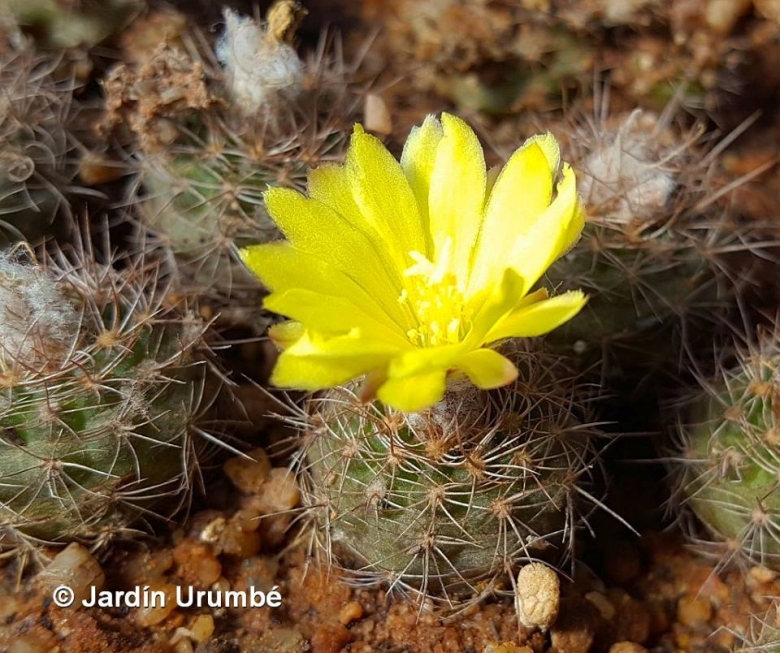




Your support is critical to our success.

Origin and Habitat: Frailea piltziiSN|33268]]SN|33268]] grows around the military posts Americo Picco and Cruce 4 de Mayo about 30 kilometers south of the massif of Cerro Leon, Nueva Asuncion, Paraguay
Altitude range: 110-190 metres above sea level.
Habitat and ecology: This species grows under the thickets of the Chaco vegetation. Fraileas are small plants that hide successfully with their mimicry.
Synonyms:
- Frailea piltzii n.n.
Description: Frailea piltziiSN|33268]]SN|33268]] is an undescribed name (nomen nudum - Abbreviation n. n. A title lacking valid description). It was first named in 1987 by the cactus collectors Bercht, Piltz and Metzing on their journey in 1988 under the thickets of the Chaco vegetation in Paraguay. It is a small, solitary plant that has a light blue to dark green epidermis and long dark spines. Often in cultivation both the stem and the spines are much lighter.
Bibliography: Major references and further lectures
1) Ludwig Bercht & Volker Schädlich. “Frailea’s ook in Paraguay.” Succulenta (Netherlands) 87(1):36-42. 2008.
2) Lubomir Berka “Paraguayaanse dwergen in de twintigste eeuw.” Succulenta (Netherlands) 79(5): 216-221, 2000.
Cultivation and Propagation: This is a is a summer grower species relatively easy to grow. It is sometime seen as a grafted plant but grows very well on its own roots too.
Growth rate: Fraileas are relatively short-lived plants, only lasting few years (rarely more than 10-15 years in cultivation) and, possible annuals in habitat! In fact they reseed readily around the base of the mother plant from self-set seed if kept reasonably moist during warm weather. It is a good idea to keep restarting them from seed; what looks like a healthy big plant may suddenly die of old age without warning.
Soil: Use mineral, slightly acidic, well permeable substratum with little organic matter (peat, humus), plants may become too elongated if compost is too rich.
Repotting: Re-pot every 2 years. Use pot with good drainage.
Fertilization: It grows much faster with a low nitrogen content fertilizer in spring and summer. Potassium helps maintaining the plants compact and healthy.
Watering: Requires careful watering to keep plant compact. Water sparingly from March till October, the thin, fibrous roots suffer if there is humidity, therefore the plant should be watered only when the surrounding terrain is dry. Keep dry as soon as the temperature starts dropping in October and keep it perfectly dry in winter at temperatures from 5 to 15 degrees centigrade.
Hardiness: They need a minimum temperature of 5-10° C (but occasionally temperatures of a few degrees below 0° are not dangerous if kept on the dry side prior to, and during, cold weather). It tends to rot in winter during the resting phase, if kept wet. In the rest period no high atmospheric humidity!!
Sun Exposure: Light shade to full sun, its colour tends to richer and darker when grown in light shade. In a shaded position the plants grow faster.
Propagation: With fresh harvested seeds. Fraileas set seed (when well grown) and grow easily from seed. In fact, they are reported to set seed even if the flower doesn’t open. This self-fertilization is called cleistogamy. Seedlings dislike strong light and dry conditions and need to be repotted frequently during the first few years. However, old plants become senile and have a tendency to succumb to disease and a weak root system. At this stage, as is well known, they die suddenly. So, after they reach about 4-5 cm in diameter grow them slowly, and adopt a new repotting period, using intervals of every 3-4 years. Additionally grow them under drier conditions or with stronger sunlight. But plants are sometine grafted to accelerate growth, but the grafted plants are typical rather tall growing, compared with plants on their own roots that are usually more flat to the ground.
| Your Actions | |
|---|---|
| Back to Frailea index | |
| Back to Cactaceae index | |
 |
Back to Cacti Encyclopedia index |
Privacy stantement - Terms and conditions - How to cite - About us - Feedback - Donate



